
The Seoul Metropolitan Subway is a metropolitan railway system consisting of 23 rapid transit, light metro, commuter rail and people mover lines located in northwest South Korea. The system serves most of the Seoul Metropolitan Area including the Incheon metropolis and satellite cities in Gyeonggi province. Some regional lines in the network stretch out beyond the Seoul Metropolitan Area to rural areas in northern Chungnam province and western Gangwon province, that lie over 100 km (62 mi) away from the capital.
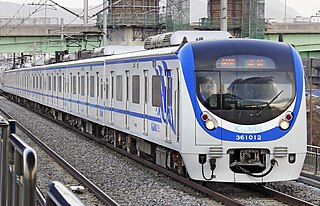
The Gyeongchun Line is a regional rail line between Seoul and Chuncheon, South Korea, operated by Korail. Its name is derived from Gyeong and Chuncheon. It was completely reconstructed in the 2000s. Service on it has operated between Sangbong station on the Jungang Line in eastern Seoul and Chuncheon station, as part of the Seoul Metropolitan Subway system, since December 21, 2010. A class of regional rail service named ITX-Cheongchun began operations on February 28, 2012, linking Chuncheon to Cheongnyangni and Yongsan Stations.

Seoul Subway Line 1 of the Seoul Metropolitan Subway is a rapid transit and commuter rail line which links central Seoul, South Korea to Yeoncheon in the northeast, Incheon in the southwest, and Sinchang via Suwon and Cheonan in the south. The central underground portion of Line 1, running underneath Sejongno, Jongno, and Wangsan-ro avenues along Seoul's traditional downtown area, is the oldest subway-operated section in the Seoul Metropolitan Subway system. Its branches and services cover a large part of the Seoul Capital Area; totaling 200.60 km (124.65 mi) in route length.

Seoul Subway Line 4 of the Seoul Metropolitan Subway is a long line crossing from the southwest to the northeast across the Seoul National Capital Area. The central section in Seoul City is operated by Seoul Metro with some trains offering through service to Korail's Ansan and Gwacheon Lines. The southern terminus (Oido) is in Jeongwang 4-dong, Siheung City, and the northern terminus (Jinjeop) is in Jinjeop-eup, Namyangju-si, Gyeonggi-do; the newly built northern section is correspondingly owned by a company owned by Namyangju-si, with operations contracted to Seoul Metro. In 2022, the Seoul Metro operated section had an annual ridership of 219,587,000 or about 601,608 passengers per day.

Seoul Metro Corporation was a municipal-owned corporation owned by the Seoul Metropolitan Government. Established in 1970, it was, with Seoul Metropolitan Rapid Transit Corporation and Korail, one of the major operators of Seoul Metropolitan Subway. The company merged with Seoul Metropolitan Rapid Transit Corporation in 2017.

Hongik University Station is a station on Seoul Subway Line 2, AREX and the Gyeongui–Jungang Line. As its name indicates, it serves the nearby Hongik University. It was formerly known as Donggyo Station, after the neighborhood that it serves.
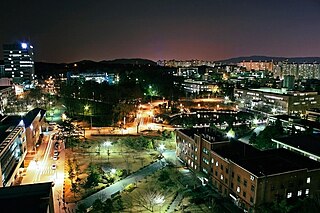
Nowon District (Nowon-gu) is a residential district of Seoul, South Korea, located in the most northeastern part of the metropolitan city. It has the highest population density in Seoul, with 619,509 people living in the area of 35.44 km².

Cheongnyangni Station (청량리역) is a major railway station located at Dongdaemun-gu, Seoul, South Korea. It serves as a terminus for passenger trains serving the eastern part of South Korea. KTX, ITX-Cheongchun, and Mugunghwa-ho trains terminates or stops at this station. Several Seoul Metropolitan Subway lines serve the station. These are: Seoul Subway Line 1, the Gyeongchun Line, the Suin–Bundang Line and the Gyeongui–Jungang Line.

Dongdaemun District is one of the 25 districts of Seoul, South Korea.
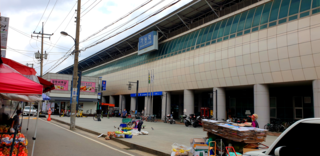
Ganeung Station is a metro station on the Line 1 of the Seoul Metropolitan Subway. The station is located in northern Uijeongbu and previously served as the northern terminus for Line 1 before its extension to Soyosan.
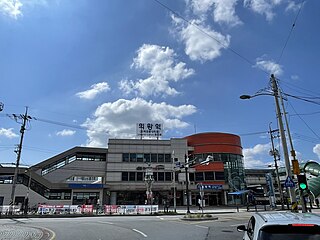
Uiwang Station is a ground-level metro station on line 1 of the Seoul Subway in Uiwang, South Korea. The station's four exits offer access to the Korea National University of Transportation, the Korean Railroad Museum and the Bugok Dong area of Uiwang. Travel time from Uiwang Station to Seoul Station on Line 1 is 50 minutes.

Namyeong station is a ground-level metro station on Seoul Subway Line 1 in Galwol Dong, Yongsan-gu, Seoul, South Korea. Subways of Line 1 move on Gyeongbu Line from this station. The station's sole exit offers access to a range of schools and Yongsan Railway Office. Travel time from Namyeong Station to Incheon on Line 1 is 65 minutes.

Gwangmyeong station (Korean: 광명역) is a train station in Gwangmyeong, South Korea. The station was newly built as a stop of national railway operator Korail's KTX high-speed service, 22.0 km (13.7 mi) south of Seoul Station.

Dobongsan Station is a subway station on the Seoul Subway Line 1 and Line 7. It is the closest station to Mt. Dobong, where its name also comes from.

Hoegi Station is a station on Seoul Subway Line 1, the Gyeongchun Line and the Gyeongui–Jungang Line. The two island platforms are side-by-side with each other, and are connected by an overpass. This is the closest station to Kyung Hee University, located northwest of here.
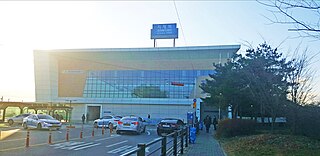
PyeongtaekJije Station is a subway station located in Pyeongtaek, South Korea. It serves the SRT and Seoul Subway Line 1. A large E-Mart store is very close to the station. On 24 November 2020, the name was changed to PyeongtaekJije.

Wolgye Station is a metro station on Seoul Subway Line 1. In the northern part of the city, it lies on the line connecting Seoul's city centre with the cities to the north in Gyeonggi-do.
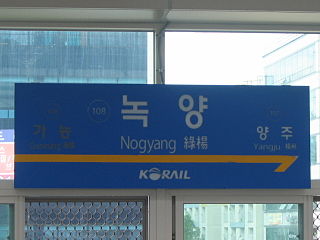
Nogyang Station is a station on the Gyeongwon Line in South Korea. It is served by Seoul Subway Line 1. The station lies in the far northern end of Uijeongbu in Gyeonggi-do.

Yangju Station is a train station on Seoul Subway Line 1 and the Gyeongwon Line. The name comes from Yangju, the city where this station is located. Until December 2007, it was called Junae Station.

Anyang Station is a ground-level subway station on Line 1 of the Seoul Metropolitan Subway. The station is located in the Anyang One neighborhood, in Manan District, Seoul. The station's sole exit offers access to Enter-6 Mall, which occupies the same building. Travel time from Anyang Station to Seoul Station on Line 1 is approximately 40 minutes. Anyang Station is the main station in Anyang, but there are another six stations in Anyang, namely Beomgye, Pyeongchon and Indeogwon on Line 4, and Myeonghak, Gwanak and Seoksu on Line 1, though the latter's platforms lie within Seoul. It is connected with Lotte Dapartment Store.






















